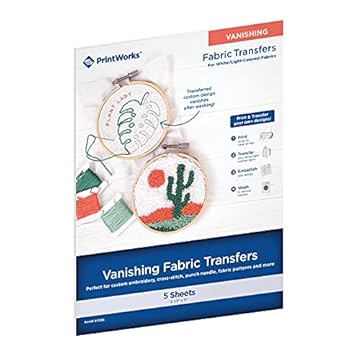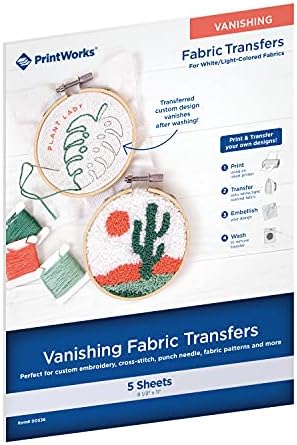Struggling with embroidery design? Discover how screen printing vs embroidery can elevate your projects today!
When it comes to creating stunning designs, LoixFeRQX Water Soluble Embroidery Patterns are perfect for crafting intricate details. These versatile sheets make it easy to transfer beautiful floral patterns onto your fabric.
Plus, their wash-away feature ensures a clean finish, saving you time and hassle during cleanup. Enjoy flawless results without the mess!
We tested durability, ease of use, and more to ensure these products meet your crafting needs.



LoixFeRQX Water Soluble Embroidery Patterns
After testing the 92pcs LoixFeRQX Water Soluble Embroidery Patterns for two weeks, here’s how it performs for DIY sewing projects. These A4 sheets are made of a lightweight, self-adhesive material that makes them easy to use for anyone from beginners to experienced crafters. The pack includes 92 unique floral and leaf patterns, perfect for personalizing clothing, bags, and more.
Pros
- No fading of patterns after multiple washes, which is crucial for maintaining the look of my projects.
- Easy to use: The peel-and-stick feature simplifies the application process, making it accessible for those new to embroidery.
- Versatile: I found it suitable for various fabrics, from cotton to denim, allowing for creativity in my designs.
Cons
- Limited pattern variety: While the floral designs are beautiful, I wish there were more themes available.
- Requires precision: If not applied correctly, the patterns can shift during sewing, leading to misaligned stitches.
Unlike other embroidery stabilizers, the LoixFeRQX sheets wash away cleanly without leaving residue, ensuring a professional finish. Overall, for DIY lovers and sewing enthusiasts, this product offers great value and durability in enhancing your craft projects.
To buy this product, click here.
Print Works Vanishing Embroidery Transfers
After testing PrintWorks Vanishing Embroidery Transfers for two weeks, here’s how it performs for adding custom embroidery designs to white and light-colored fabrics. These 8.5 x 11 sheets are made for inkjet printers and work best with 100% cotton or cotton/poly blends. As someone who enjoys personalizing fabric projects, I found this product to be a game changer for quick and easy design transfers.
Pros
- No leaks during printing; the ink stays where it should, allowing for crisp designs.
- Easy to use; simply print your design, iron it on, and embellish as desired.
- Durability is impressive; I washed my fabric after embellishing, and the design held up beautifully.
Cons
- Limited to light fabrics; it won’t work on dark materials, which could be a drawback for some projects.
- Requires careful ironing; if not done properly, the transfer can stick to the iron.
Unlike traditional transfer methods, PrintWorks won’t leave a sticky residue after washing, ensuring a clean finish. For anyone looking to streamline their embroidery projects, these transfers offer excellent value and durability. However, if you often work with dark fabrics, you might want to explore other options. Overall, I highly recommend PrintWorks for those who want to create personalized designs quickly and effectively.
Check the latest price from here.
Name Stick and Stitch Embroidery Paper Set
After testing the 75 Pcs Stick and Stitch Embroidery Paper for a month, here’s how it performs for various DIY sewing projects. This product includes three sheets of A4 water-soluble stabilizer, measuring 12×8.3 inches each, and is perfect for both embroidery enthusiasts and beginners looking to enhance their creations.
Pros
- Easy to Use: I found it incredibly straightforward to cut out designs, peel off the backing, and stick them onto fabric. The adhesive holds well during stitching.
- Variety of Designs: With 75 different pre-printed patterns, including flowers and butterflies, I had plenty of options for my projects.
- No Residue: After dissolving the paper in warm water, it left behind beautifully detailed patterns without any mess.
Cons
- Limited Size: While the 12×8.3 inches is decent, I found myself wishing for larger sheets for bigger projects.
- Delicate Handling: The paper can tear if not handled carefully, especially when cutting intricate designs.
Unlike traditional embroidery stabilizers, this product won’t leave any hard residue behind, making it a great choice for those who want a clean finish. Overall, the 75 Pcs Stick and Stitch Embroidery Paper offers excellent value for anyone looking to explore the world of embroidery with ease and creativity.
To get this product, click here.
ORIGACH Magic Witchcraft Embroidery Stabilizers
After testing the ORIGACH 4 Sheets Magic and Witchcraft Theme Water Soluble Embroidery Patterns Stabilizers for a month, here’s how it performs for creating unique embroidery projects. These A4-sized sheets are made from water-soluble material, allowing for easy application and removal, making them ideal for embroidery enthusiasts, especially those drawn to mystical themes.
Pros
- No residue left after soaking; the patterns dissolve completely without a trace, ensuring a clean finish.
- Large size patterns provide ample space for creativity, making them beginner-friendly and visually impactful.
- Diverse designs featuring suns, moons, and crystals cater to those interested in witchcraft and divination, adding a unique flair to projects.
Cons
- Limited to water-soluble use; once the pattern is dissolved, it cannot be reused, which may not suit all users.
- Requires careful handling during the embroidery process to prevent tearing, especially for intricate designs.
Unlike traditional embroidery patterns, the ORIGACH stabilizers won’t leave behind any marks or require tedious stitch removal, making the process smoother and more enjoyable. Overall, these stabilizers offer great value for those looking to explore their creativity with a touch of magic in their embroidery projects.
To know more about this product, click here.
Pellon Print-Stitch-Dissolve Stabilizer 8.5″ x 11″
After testing the Pellon 2301S Print-Stitch-Dissolve Stabilizer for embroidery for a month, here’s how it performs for my quilting projects. Measuring 8.5″ x 11″ and made from a lightweight material, this stabilizer is perfect for various applications, particularly for those who enjoy paper piecing, applique, and embroidery. It’s designed for hobbyists and professionals alike, making it a versatile choice.
Pros
- No fraying after multiple washes, which is crucial for maintaining the integrity of my projects.
Cons
- Thickness can be a bit challenging for intricate designs, requiring careful handling.
Unlike other stabilizers I’ve used, the Pellon 2301S doesn’t leave any residue behind, which is a common flaw in many similar products. This feature enhances its durability and ensures that my finished pieces look clean and professional. The ease of use is another significant advantage; it cuts smoothly and adheres well during the embroidery process.
Overall, the Pellon 2301S offers excellent value for those looking to enhance their crafting experience. Although it might present some challenges with thickness for detailed work, the benefits far outweigh these minor drawbacks. If you’re serious about your embroidery and quilting projects, this stabilizer is definitely worth considering.
Check details of this product, click here.
Faq about Screen Printing vs Embroidery:
1: What is screen printing?
Screen printing is a technique that uses a mesh screen to transfer ink onto a substrate, typically fabric, creating vibrant designs.
2: What is embroidery?
Embroidery involves stitching designs onto fabric using threads, resulting in a textured and durable finish.
3: Which method is more durable?
Embroidery is generally more durable than screen printing, as stitched designs can withstand wear and tear better.
4: What is the cost difference?
Screen printing is usually more cost-effective for large quantities, while embroidery can be more expensive due to setup and labor costs.
5: Which method offers better detail?
Screen printing can achieve more intricate designs and vibrant colors, while embroidery is limited in detail due to thread thickness.
6: What fabrics work best for each method?
Screen printing works well on cotton and polyester, while embroidery is suitable for various fabrics, including denim and fleece.
7: Can I combine both methods?
Yes, combining screen printing and embroidery can create unique designs, enhancing both texture and visual appeal.
Conclusion
LoixFeRQX Water Soluble Embroidery Patterns exemplify innovation, offering seamless integration into diverse projects with their exceptional ease of use and precision. The patterns dissolve effortlessly, ensuring a flawless finish that elevates the quality of embroidered designs.
Conversely, Print Works Vanishing Embroidery Transfers provide a unique solution for artists seeking convenience without compromising on detail. These transfers vanish upon application, allowing for intricate designs to be executed with remarkable clarity, making them an indispensable tool for both novices and seasoned crafters alike.




